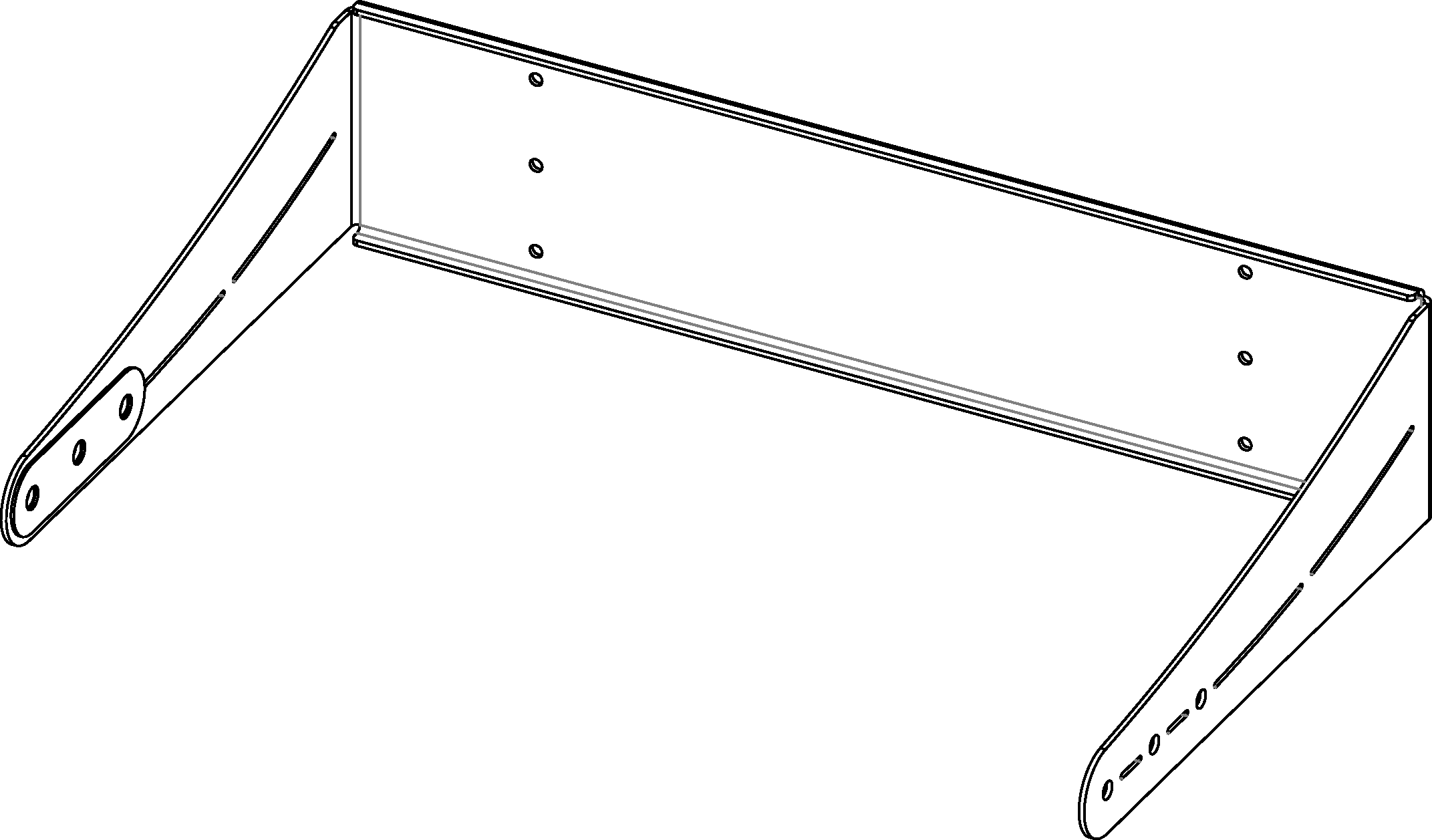Datasheet — Amie-Sub
Compact studio and cinema subwoofer
The linear, self-powered Amie-Sub compact subwoofer offers outstanding sonic characteristics, such as clean, punchy transients and excellent phase coherence with impressive low-frequencies down to 22 Hz in a compact cabinet.


Amie-Sub Loudspeaker and Dimensions
The Amie-Sub was specifically designed to be the perfect companion for Amie precision monitors—creating a complete system by extending the system frequency response down to the lower limit of the audible range with easy integration in multi-channel configurations.
In addition, due to its performance and versatility, the Amie-Sub is equally suited to complement other Meyer Sound loudspeakers, such as HMS-5, HMS-10, HMS-12, and HMS-15 in immersive surround applications or across other more general applications with UltraSeries loudspeakers.
Extensive research and measurements resulted in the creation of Amie-Sub integration modules to produce consistent behavior across multiple configurations and environments.
The optional integration modules enable the Amie-Sub to excel at working in any multichannel configuration, creating a perfectly balanced and easy-to-set-up system with up to 7 Amie precision monitors.
The 2.1 integration module features 2 input channels using XLR connectors, while the 7.1 module features industry-standard multi-pin DB-25 and can be used in 5.1 or 7.1 configurations with third-party, high-quality, 8-channel, DB-25-to-XLR cables.
The integration modules feature bass management processing as well as a dedicated phase-matched .1 input for the LFE channel with selectable +10 dB boost to meet a variety of standards.
The Amie-Sub has an operating frequency range of 22–160 Hz and a linear peak SPL of 124.5 dB with crest factor >11.5 dB, measured in half-space at 4 m and referred to 1 m using M-noise.
The Amie-Sub includes a single 15-inch, low distortion, long-excursion cone driver. The bass reflex cabinet employs an optimized port design for high efficiency and low port distortion. Its slanted connector panel facilitates flush-mounting the cabinet against wall surfaces, reducing the required installation depth to 19 inches including connectors.
The cabinet houses a Class D power amplifier and signal processing includes crossover, driver protection, and frequency and phase correction.
The Intelligent AC™ power supply provides automatic voltage selection, EMI filtering, soft current turn-on, and surge suppression.
Meyer Sound builds the Amie-Sub cabinet from premium birch plywood coated with a durable, slightly textured finish and includes a stamped-steel grille to protect the drivers. A grille frame with black cloth that mounts on top of the steel grille is optionally available.
The Amie-Sub comes standard with two 3/8-inch by 16 mounting points on each side for use with the optional MUB-Amie-Sub U-bracket for mounting the subwoofer from ceilings.
Features and Benefits
Linear frequency, phase and amplitude response with sonic accuracy at any level with high peak power output and excellent transient reproduction
Extended low frequency range down to 22 Hz
Extremely low distortion for exceptional low-frequency clarity
Optional modules allow seamless integration with Amie precision monitors to create bass-managed stereo systems and immersive systems up to 7.1
Self-powered design simplifies setup and increases reliability
Integrates with HMS-5, HMS-10, HMS-12 and HMS-15 surround loudspeakers in immersive applications
Integrates with UltraSeries loudspeakers in general applications.
Optional U-bracket allows flexibility of mounting in ceilings
Applications
Small- to medium-sized mixing or editing rooms
Stereo and immersive mixing for music, film and video post-production
Broadcast monitoring
Music, film and video editing
Fixed installations requiring a compact high-power subwoofer
Any installation requiring a compact a low-distortion, high-power subwoofer that goes down to 22 Hz.
High-end playback systems
Accessories
MUB-Amie-Sub U-Bracket — Enables mounting of an Amie-Sub cabinet on a ceiling; uses side M8 mounting points on the Amie-Sub cabinet.
 |
MUB-Amie-Sub U-Bracket
2.1 Integration Input Module — Enables the Amie-Sub to create a bass-managed stereo system or a 2.1 system with LFE input using XLR connectors.
 |
2.1 Integration Input Module
7.1 Integration Input Module — Enables the Amie-Sub to create a bass-managed system up to 7.1 channels using multi-pin DB-25 female connectors on the panel. Third-party, high-quality, 8-channel DB-25 male connectors to XLR cables are required and not included.
 |
7.1 Integration Input Module
Black Cloth Grille Frame — Grille frame with black cloth that mounts on top of the steel grille is optionally available for applications where this appearance is more desirable.
 |
Black Cloth Grille Frame
Specifications
ACOUSTICAL1 | |
Operating Frequency Range2 | 22 Hz – 160 Hz |
Frequency Response3 | 25 Hz – 145 Hz ±4 dB |
Phase Response | 33 Hz – 145 Hz ±30° |
Linear Peak SPL4 | 124.5 dB with >11.5 dB crest factor (M-noise), 124.5 dB (Pink noise), 126 dB (B-noise) |
COVERAGE | |
360° (single unit); varies with number of units and configuration | |
TRANSDUCERS | |
Low Frequency | One 15 inch long-excursion cone driver; 3 Ω nominal impedance |
AUDIO INPUT | |
Type | Differential, electronically balanced |
Maximum Common Mode Range | ±15 V DC, clamped to earth for transient voltage protections |
Input Impedance | 10 kΩ differential between Audio(+) and Audio(– ) |
Nominal Input Sensitivity | 6 dBV (2.0 V rms) continuous is typically the onset of limiting for noise and music |
Input Level | Audio source must be capable of producing of +20 dBV (10 V rms) into 600 Ω to produce the maximum peak SPL over the operating bandwidth of the loudspeaker. |
XLR Wiring | Pin 1: Chassis/earth through 1 kΩ, 1000 pF, 15 V clamp network to provide virtual ground lift at audio frequencies Pin 2: Audio(+) Pin 3: Audio(–) Case: Earth ground and chassis |
Looping Input Module Connectors | XLR 3-pin female with male loop output |
2.1 Integration Module Connectors | XLR 3-pin female inputs (channels 1, 2 and LFE) XLR 3-pin male loop outputs (channels 1 and 2) |
7.1 Integration Module Connectors5 | DB-25 female connector inputs (channels 1 to 7 and LFE) DB-25 female connector outputs (channels 1 to 7 and LFE + bass management) |
AMPLIFIER | |
Type | 2-channel, open-loop, class D |
Total Output Power6 | 1100 W peak |
THD, IM, TIM | < 0.02% |
Cooling | Convection |
AC POWER | |
Connector | powerCON 20 input with loop output to feed Amie loudspeakers |
Automatic Voltage Selection | 90–265 V AC |
Safety Rated Voltage Range | 100–240 V AC, 50–60 Hz |
Turn-on and Turn-off Points | 90 V AC turn-on, no turn-off; internal fuse-protection above 265 V AC |
CURRENT DRAW | |
Idle Current | 0.25 A rms (115 V AC); 0.23 A rms (230 V AC); 0.25 A rms (100 V AC) |
Maximum Long-Term Continuous Current (>10 sec) | 1.4 A rms (115 V AC); 0.7 A rms (230 V AC); 1.5 A rms (100 V AC) |
Burst Current (<1 sec)7 | 2.9 A rms (115 V AC); 1.5 A rms (230 V AC); 3.4 A rms (100 V AC) |
Maximum Instantaneous Peak Current | 7.4 A peak (115 V AC); 3.7 A peak (230 V AC); 8.5 A peak (100 V AC) |
Inrush Current | <20.0 A peak |
PHYSICAL | |
Dimensions | W: 24.00 in (609 mm) x H: 17.5 in (444 mm) x D: 19.00 in (482 mm) |
Weight | 74 lb (33.5 kg) |
Enclosure | Premium multi-ply birch with low-gloss, slightly textured black finish |
Protective Grille | Powder-coated, hex-stamped steel with optional black cloth grille that attaches to the steel grille |
Rigging | Side nut-plates with 3/8-inch by 16 threads for the optional MUB-Amie-Sub U-bracket |
Notes
Loudspeaker system predictions for coverage and SPL are available in Meyer Sound’s MAPP System Design Tool.
Recommended maximum operating frequency range. Response depends on loading conditions and room acoustics.
Measured in half-space with pink noise at 4 m, 1/3-octave frequency resolution.
Linear Peak SPL is measured in half-space at 4 m referred to 1 m. Loudspeaker SPL compression measured with M-noise at the onset of limiting, 2-hour duration, and 50 °C ambient temperature is <2 dB.
M-noise is a full bandwidth, (10 Hz–22.5 kHz) test signal developed by Meyer Sound to better measure the loudspeaker’s music performance. It has a constant instantaneous peak level in octave bands, a crest factor that increases with frequency, and a full bandwidth Peak to RMS ratio of 18 dB. The presence of a greater-than (>) symbol with regard to crest factor indicates it may be higher depending on EQ and boundary loading.
Pink noise is a full bandwidth test signal with Peak to RMS ratio of 12.5 dB.
B-noise is a Meyer Sound test signal used to ensure measurements reflect system behavior when reproducing the most common input spectrum, and to verify there is still headroom over pink noise.
The DB-25 multi-pin connectors are wired to an analog pinout that has become the standard in the audio industry; it is sometimes referred to as the Tascam® DTRS pinout.
Peak power based on the maximum unclipped peak voltage the amplifier will produce into the nominal load impedance.
AC power cabling must be of sufficient gauge so that under burst current rms conditions, cable transmission losses do not cause the loudspeaker’s voltage to drop below the specified operating range.
Architectural Specifications
The loudspeaker shall be a self-powered, sub-bass system. The transducer shall consist of one 15-inch long excursion cone driver. The loudspeaker shall incorporate a 2-channel, open-loop, class D amplifier.
Performance specifications for a typical production unit shall be as follows, measured at 1/3-octave resolution: operating frequency range shall be 22–160 Hz; frequency response shall be 25–145 Hz ±4 dB; phase response shall be 33–145 Hz ±30°; linear peak SPL shall be 124.5 dB with >11.5 dB crest factor, measured in half-space with M-noise at 4 m referred to 1 m.
The loudspeaker shall be equipped standard with an XLR 3-pin looping input panel. Optionally, the loudspeaker could be equipped with an XLR multiple 3-pin connector integration module to create a 2.1 system or a DB-25 multi-pin connector module to create a 7.1 immersive system. The audio input shall be differential and electronically balanced with 10 kΩ impedance, and a continuous 6 dBV (2 V rms) input signal shall typically drive the speaker to the onset of limiting for noise and music.
Power requirements for the loudspeaker shall be 100–240 V AC, 50–60 Hz. Maximum long-term continuous current draw for the loudspeaker (> 10 sec) shall be 1.4 A rms (115 V AC); 0.7 A rms (230 V AC); 1.5 A rms (100 V AC). The power supply shall provide automatic voltage selection, EMI filtering, soft current turn-on, and surge suppression.
All components shall be mounted in an acoustically vented, box-shaped enclosure constructed of premium multi-ply birch with a slightly textured black finish. Left and right sides shall incorporate 3/8-inch by 16 threads. The front protective grille shall be powder-coated, hex-stamped steel.
Dimensions for the loudspeaker shall be W: 24.00 in (609 mm) x H: 17.5 in (444 mm) x D: 19.00 in (482 mm) without mounting bracket. Weight shall be 74 lb (33.5 kg).
The loudspeaker shall be the Meyer Sound Amie-Sub.